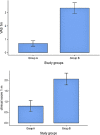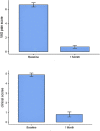The role of vitamin D in amelioration of oral lichen planus and its effect on salivary and tissue IFN-γ level: a randomized clinical trial
- PMID: 39020381
- PMCID: PMC11256592
- DOI: 10.1186/s12903-024-04239-0
The role of vitamin D in amelioration of oral lichen planus and its effect on salivary and tissue IFN-γ level: a randomized clinical trial
Abstract
Background and objectives: Oral lichen planus (OLP) is a common, prevalent, immune-mediated, inflammatory disease affecting both the skin and oral mucosa and is considered one of the potentially malignant diseases. Since OLP is regarded as an immunologically mediated disease, some studies suggest the use of vitamin D (VD) for its management as it exhibits immune-modulatory, anti-inflammatory, and antimicrobial properties, as well as anti-proliferative, pro-differentiative, and anti-angiogenic effects. VD has demonstrated a suppressive effect on TH1 pro-inflammatory cytokines, including IFN-γ while augmenting the secretion of anti-inflammatory cytokines. At the same time, VD deficiency is a prevalent public issue. Therefore, the present study aimed to investigate the role of VD as an adjunct to steroids in the management of VD-deficient OLP patients as well as its inhibitory effect on IFN-γ through measurement of salivary and tissue IFN-γ levels in OLP patients.
Methods: A total of 40 patients with ulcerative or erythematous OLP, diagnosed according to the World Health Organization's (WHO) modified criteria for OLP, were randomly allocated into one of the two study groups to receive either systemic steroids in addition to VD supplements (Group A) or systemic steroids only (Group B). Blood samples were collected for the measurement of serum VD level (SVDL) using the enzyme-linked immunosorbent assay (ELISA) to involve only patients with VD deficiency or insufficiency (≤ 30 ng/ml). Clinical evaluation of the lesion involved objective signs and subjective symptoms. Also, changes in salivary and tissue INF-γ levels (in pg/mL and pg/mg, respectively) were determined using the ELISA technique. All parameters were measured at baseline and after 4 weeks of treatment. The clinical pharmacy team devised a checklist to record all team interventions. The interventions were categorized into six domains, including drug interactions and/or adverse reactions, medication dose issues, drug selection issues, support with medication history, patient-related concerns, and suggestions for dental medication.
Results: After one month of treatment, a significantly greater number of patients in group A showed complete pain relief and resolution of clinical lesions, as well as a greater number of patients showing a reduction in the clinical severity of lesions than in group B (P = 0.005). Also, there was a statistically significant reduction in average VAS pain scores and clinical scores in group A compared to group B after 1 month of treatment (P = 0.001 and 0.002, respectively). Furthermore, there was a statistically significant greater reduction in salivary and tissue IFN-γ levels in group A than in group B (P ≤ 0.001 and 0.029, respectively) after 1 month of treatment.
Conclusion: Current evidence suggests a significant preventive and therapeutic role for VD as an adjunct to standard therapies indicated for OLP lesions. These protective and therapeutic functions are achieved through the suppressive effect of VD on pro-inflammatory cytokines, particularly IFN-γ. Also, salivary IFN-γ appears to be a valuable prognostic marker for monitoring the progression of OLP. In addition, the inter-professional collaboration between dentists and clinical pharmacists helped to deliver complete, patient-centered primary care and ensured the quality of the medications included in patient kits, thus improving patient treatment and management. Nevertheless, further studies with larger sample sizes, longer follow-ups, and standardized designs may still be needed.
Keywords: Interferon-gamma; OLP lesions; Oral lichen planus; Oral potentially malignant lesions; Salivary IFN-γ; Vitamin D; Vitamin D receptors.
© 2024. The Author(s).
Conflict of interest statement
The authors declare that they have no competing interests regarding the publication of this paper.
Figures







References
-
- Mozaffari HR, Sharifi R, Hayati M, Imani MM, Lopez-Jornet P, Golshah A, et al. Evaluation of serum and salivary interferon-γ levels in patients with oral lichen planus: a systematic review and meta-analysis of case-control studies. Oral Surgery, Oral Medicine, Oral Pathology and Oral Radiology. 2019;127(3):210-7. - PubMed
Publication types
MeSH terms
Substances
LinkOut - more resources
Full Text Sources
Medical

